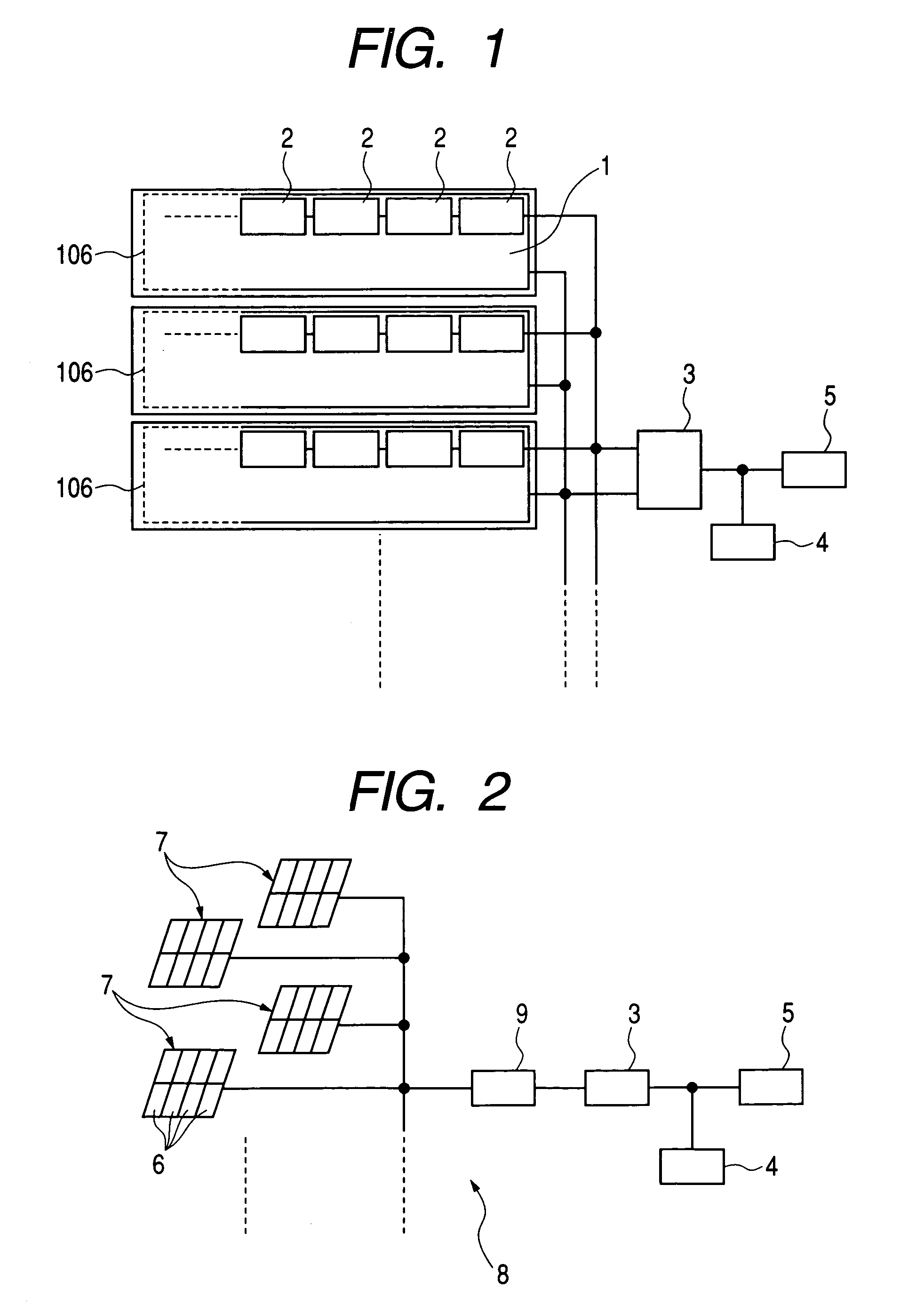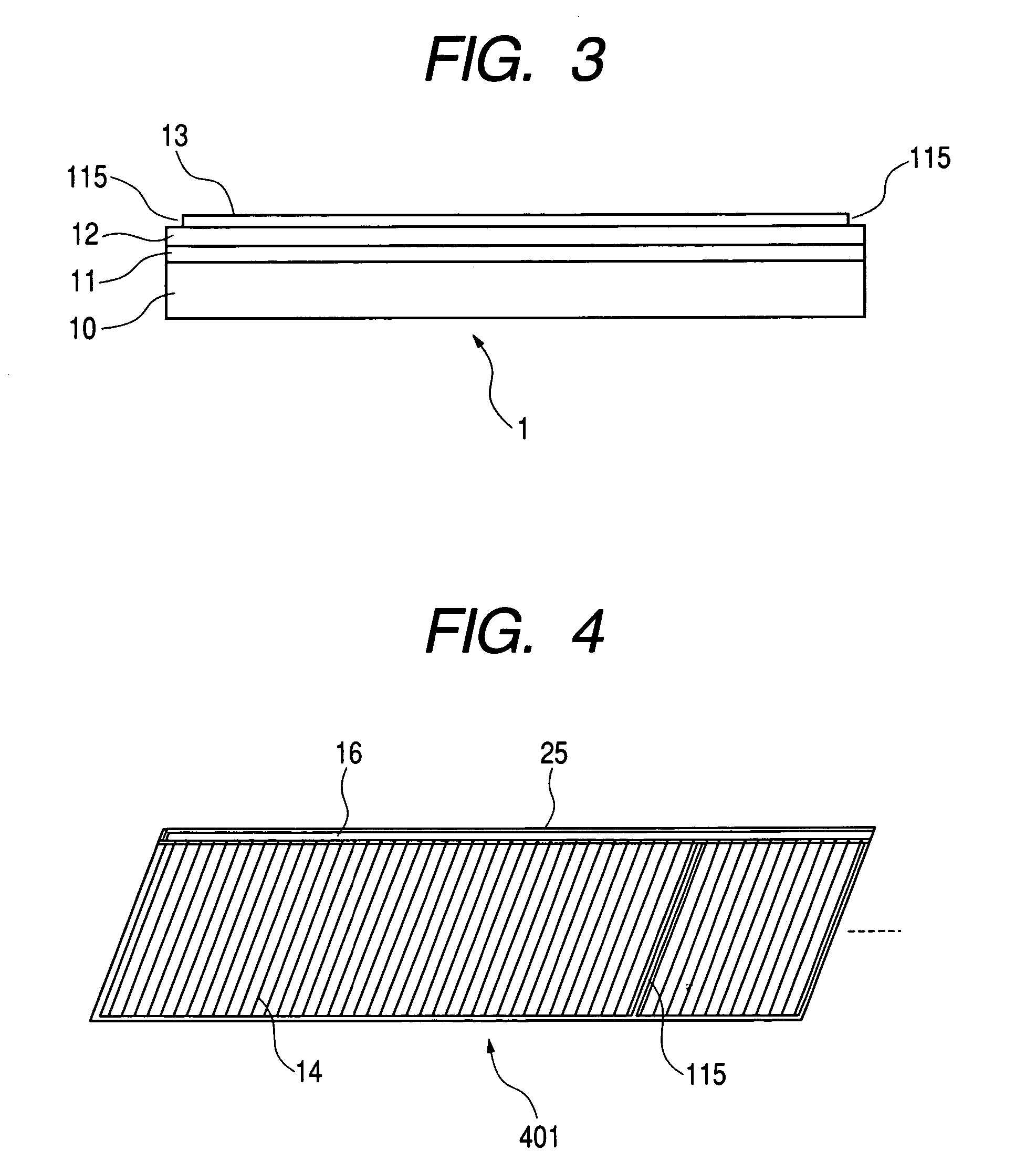Photovoltaic power generating apparatus, method of producing same and photovoltaic power generating system
a photovoltaic power generation and photovoltaic technology, applied in the direction of machines/engines, propulsion parts, process and machine control, etc., can solve the problems of increasing the non-power generation area not used for power generation in reducing the efficiency of area power generation of the solar cell module, and taking time and trouble. , to achieve the effect of reducing the influence of partial shadows and reducing production costs
- Summary
- Abstract
- Description
- Claims
- Application Information
AI Technical Summary
Benefits of technology
Problems solved by technology
Method used
Image
Examples
first embodiment
(First Embodiment)
[0077]FIG. 1 is a schematic view showing a configuration of a photovoltaic power generating system according to a first embodiment of the present invention. Reference numeral 1 denotes a single solar cell element formed on a conductive substrate, 2 denotes a DC-DC converter, 3 denotes an inverter, 4 denotes a load and 5 denotes a commercial system.
[0078]The term “solar cell element” used herein refers to a minimum unit having the function as a solar cell capable of extracting electric power. For example, when a power generation area is segmented by etching lines, the solar cell element refers to a certain area having a photovoltaic layer segmented by etching lines, etc., which is a minimum unit having the function as a solar cell capable of extracting electric power therefrom. The solar cell element is not limited to one having a single photoelectric conversion layer and may also have a plurality of photoelectric conversion layers stacked one upon another. Examples...
second embodiment
(Second Embodiment)
[0187]A second embodiment of the photovoltaic power generating system according to the present invention will be explained below. Explanations of the same parts as those of the first embodiment will be omitted and characteristic parts of this embodiment will be principally explained below.
[0188]FIG. 10 is an external view showing a schematic configuration of the second embodiment and FIG. 11 is an equivalent circuit diagram of the second embodiment.
[0189]As a solar cell element 1 of this embodiment, substantially the same one as that of the first embodiment is used and detailed explanations thereof will be omitted.
[0190]FIG. 12 is an enlarged view of a connection portion between the solar cell element 1 and DC-DC converter 2 of this embodiment. Here, the position in the solar cell element at which the DC-DC converter 2 is attached is the same as that of the first embodiment, but the second embodiment is different in that an output terminal 59 is drawn out of the e...
third embodiment
(Third Embodiment)
[0203]A third embodiment of the photovoltaic power generating system according to the present invention will be explained below. Explanations of the same parts as those of the first embodiment and second embodiment will be omitted and characteristic parts of this embodiment will be principally explained below.
[0204]A solar cell element used in this embodiment has substantially the same configuration as that used in the first embodiment, but it is different only in a stacked configuration of the semiconductor layer.
[0205]More specifically, on a roll-shaped, cleaned, long stainless steel substrate of 0.1 mm thick as a conductive substrate, a layer of Al containing 1% of Si was formed using a sputtering method in a film thickness of 5,000 Å as a lower electrode layer. Then, an n / i / p-type amorphous silicon semiconductor layer was formed using B2H6, SiH4 and H2 gases for a p-type semiconductor, SiH4 and H2 gases for an i-type semiconductor and PH3, SiH4 and H2 gases for...
PUM
 Login to View More
Login to View More Abstract
Description
Claims
Application Information
 Login to View More
Login to View More - R&D
- Intellectual Property
- Life Sciences
- Materials
- Tech Scout
- Unparalleled Data Quality
- Higher Quality Content
- 60% Fewer Hallucinations
Browse by: Latest US Patents, China's latest patents, Technical Efficacy Thesaurus, Application Domain, Technology Topic, Popular Technical Reports.
© 2025 PatSnap. All rights reserved.Legal|Privacy policy|Modern Slavery Act Transparency Statement|Sitemap|About US| Contact US: help@patsnap.com



